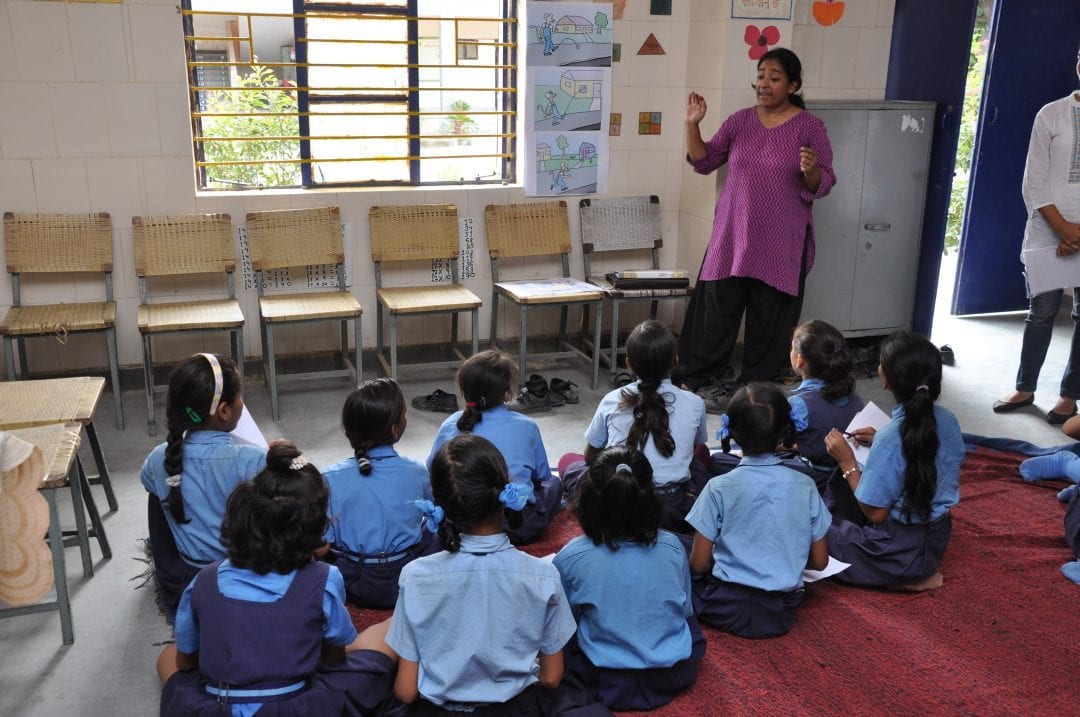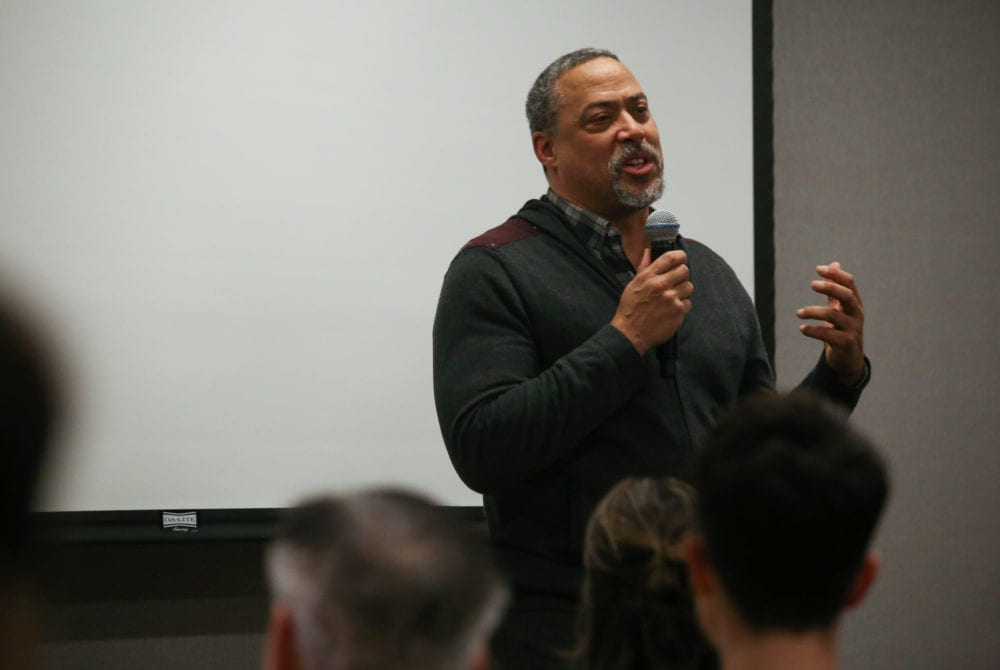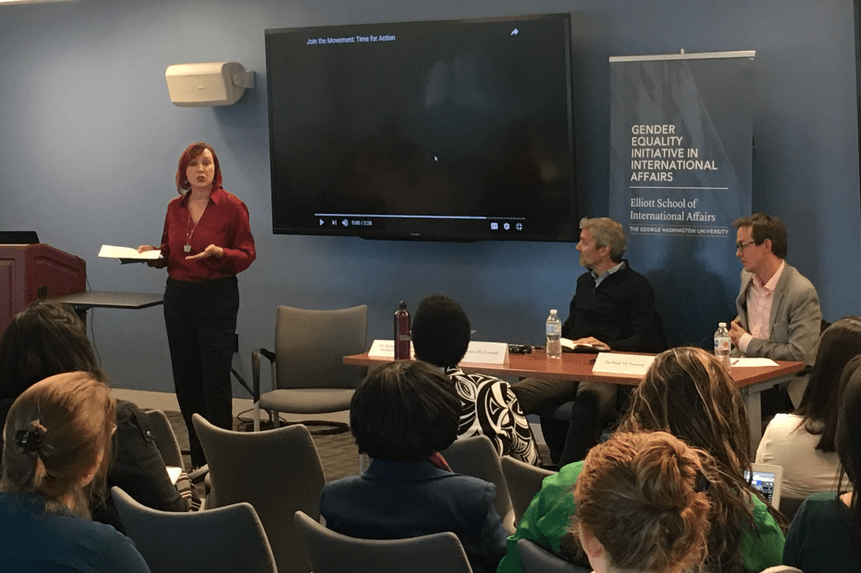
The election of December 1918 took place just one month after the armistice that brought the First World War to an end. A year of many firsts, 1918 was the first time Irish women were permitted by law to vote and stand in parliamentary elections. That same year, Countess Constance Markievicz was the first woman ever to be elected to the Westminster parliament, although she refused to take her seat there. (Read more about the Irish women’s suffrage movement in 1918.)
Irish representatives elected in December were invited to meet in Dublin a month later to establish the First Dáil (Parliament). One hundred years ago, on 21 January 1919, the first Dáil met in the Round Room of the Mansion House. During the two-hour sitting, Dáil Members adopted a Constitution and read out a Declaration of Independence, first in Irish, then in French and, finally, in English.
To celebrate the centenary of the First Dáil, Ambassador Daniel Mulhall hosted a panel discussion with GEIA Director Dr. Shirley Graham and Dr. Jennifer Wells of The George Washington University on the impact of the 1918 election and the legacy of the First Dáil.
Following her remarks, Dr. Graham shared a poem “Our future will become the past of other women” by Eavan Boland. Boland’s commissioned poem on women’s suffrage recited at the UN General Assembly was an initiative of the Department of Foreign Affairs in partnership with the Royal Irish Academy on the eve of the centenary of the 1918 General Election. View the full poem. Please see the poem’s illustration pictured above left.
Dr. Graham’s remarks are as follows:
Good evening ladies and gentlemen, Ambassador Mulhall thank you for inviting me to speak at this important event celebrating the First Irish Dail, it is an honour and a privilege.
Friends, imagine for a moment this scene: a 90 year old woman, surrounded by cheering crowds waving flags and flowers, as she casts her first ever ballot vote in December 1918. Who was this woman and why was she met in the streets of Dublin with such delight? It was Anna Haslam, who along with her husband Thomas, was the founder of the Dublin Women’s Suffragette Association and who spent 40 years campaigning for women’s right to vote and stand for election. She was casting her vote at a time when many of our grandmothers or great grandmothers were either girls or young women, hopeful for a new Ireland, one which cherished all of its children and treated its women and men equally. But what kind of lives did our grandmothers actually live?
In 1918 women gained only partial franchise, voting rights were given to women aged 30 or over who owned property or had a university degree. It wasn’t until 1922 that Irish women gained full suffrage (1).
The reason why I began my remarks by remembering Anna Haslam, is to remind us all that the remarkable achievements in 1918 of the women’s suffrage movement that led to the election of Countess Markievicz as the first woman MP in the Houses of Westminster, and subsequently the only woman in the First Dail, was as a result of the tireless and courageous campaigning of hundreds of women over many years.
But up until the recent centenary commemorations many of these women were invisible in Irish history, unknown and without voice. Although, Irish feminist historians (2) have been writing these women back into history for many years, in secondary schools today when teaching about the 1916 era, only two women are discussed: Constance Markievicz and the artist Evie Hone, even though 500 women took part in the Rising (3).
Let us return to the historic moment when Countess Markievicz was elected. As I’m sure you know, she was a woman of contrasts and contradictions. A member of the aristocracy, a socialite, a feminist, a suffragist, a military leader: second in command of the Irish Citizen Army, a republican, a politician and an artist. In fact, it was while she was studying at the Slade School of Art in London in 1893, that she was first exposed to the cause of women’s suffrage, inspiring her political activism and later on her fight for the nationalist cause. (4)
As a political representative and a minister in the First Dail, Markievicz was stepping into a new role for women, one that she and her supporters could previously only imagine. An imagination that did not extend to all, as was revealed in her letter from Westminster inviting her to take her seat in Parliament, which saluted her as ‘Dear Sir’!
If ‘a community is imagined more than it is actually met and connected with’ (5), what was it that enabled Irish women to imagine a new gender equal Ireland? To answer that question we first have to ask: ‘Where were the women? What roles, responsibilities and duties did they hold? Were those roles and responsibilities valued? How did those roles enable them to gain the vote and stand for election?
So, where were women in the lead up to the creation of the First Irish Dail? Women were creating inspirational and revolutionary organizations such as Inghidhne na hEireann, the Irish Women’s Franchise League, the Irish Women’s Suffrage Federation, the North of Ireland Women’s Suffrage Society, the Irish Women’s Union and Cumann na mBan. They were publishing and distributing their own newspapers, such as Bean na hEireann and The Irish Citizen newspaper, providing a public space for women to express their political views. Feminist women leaders were carving out a space for public discourse on gender inequality in an Ireland that positioned women firmly in the home and dependent on male breadwinners.
What roles, responsibilities and duties did women hold? From the late 1800s Women were taking on roles as social activists raising awareness of injustices such as overcrowded housing, domestic violence, lack of access to family planning, and the discriminatory treatment of the Contagious Diseases Act, which led to women prostitutes with venereal diseases forced into Lock hospitals for up to nine months.
Women were military leaders in the nationalist cause as well as combatants, intelligence gatherers, couriers, fundraisers, and nurses. Women were also proponents of non-violent means of gaining Irish independence, promoting and circulating pamphlets on pacifism. (6)
By 1914 she was a prominent member of the Irish Citizen Army, advocating the need for an armed rebellion. She commissioned photographs portraying herself as a military leader prepared to fight for Ireland and proffering practical advice to her fellow women activists ‘Dress suitably and buy a revolver’.
Were these roles, responsibilities and duties valued in society? After the Third home rule bill (1914) excluded women from voting the frustrated suffrage movement became more militant. Women took to their platforms speaking out against this and the many other discriminations they faced, and while they inspirational for many, they were also heckled, jeered and harassed by members of the crowds. The women who smashed windows in the GPO, Dublin Castle and other government buildings, were often beaten by the police as well as members of the public, and then imprisoned for civil disobedience, only released after prolonged hunger strikes, and in some cases, force feeding (7).
These women didn’t know that they would succeed, and yet they risked their lives, their health, and their livelihoods (for example Hanna Sheehy Skeffington lost three teaching jobs due to her activism) (8) to ensure that we, future generations of women could vote.
At the same time that women were fighting for the feminist cause they were also fighting for the nationalist cause. Although women were active alongside their male comrades they were not always taken seriously in these combatant roles. For example, after the 1916 Rising, the 77 women who were imprisoned in Richmond Barracks had initially been told to ‘go back to their homes’ (9), but they refused, and insisted on being treated the same as revolutionary men. These women who were depicted as ‘unmanageable revolutionaries’ came from all walks of life, they were teachers, factory workers, journalists, shop workers, and doctors. For them the Easter Rising was not only about Irish freedom and sovereignty it was also about women’s freedom and sovereignty.
In the lead up to the 1918 elections women lobbied male leaders in Sinn Fein asking them to ensure there was a gender quota in the elections. However, only two women were put forward: Countess Markievicz for St Patrick’s Ward in Dublin, and Winifred Carney for the unwinnable seat in East Belfast. It was assumed that Maud Gonne and Katherine Clarke would be included, but they were not, and as Hanna Sheehy-Skeffington was offered an unwinnable seat she declined to stand (10).
In fact, there was confusion about whether women could stand as candidates at all and the Sinn Féin convention passed a resolution stating that no candidate should stand “other than a man who took part of the fight of Easter Week”. As a result, women’s preparation for candidacy was rushed with suffragists working tirelessly to support the two women candidates, putting up posters, giving speeches and organising numerous meetings and rallies. Already, women were being left behind by the male leadership in Sinn Fein.
On the day that Markievicz’s election was declared, The Irish Citizen, newspaper triumphantly proclaimed: ‘And so Ireland again leads the way, and while Britain wallows in reaction and turns her back on woman MPs, Ireland proudly writes “Progress” on her banner to show the world how much in advance she is of those who would rule her (11).
Sadly, as we know, that progress towards gender equality was short-lived for Irish women, following independence the new state’s deep conservatism, patriarchal control and influence of the Catholic Church pushed women back into their homes. It would be another 60 years before Ireland had its second woman minister, Maire Geoghan Quinn. Today, women make up 22% of the Dail, 30% of the Seanad and only four of 15 ministers.
Of course in recent years there have been many important achievements made towards women’s rights, not least two inspirational women Presidents, Mary Robinson and Mary McAleese. Other developments towards gender equality include: the Repeal of the 8th Amendment giving women access to their full reproductive rights through access to legal and safe abortions; Marriage Equality creating legislation enabling same sex marriages; Waking the Feminists raising awareness of bias in theatres towards male playwrights, directors, and producers; the Parliamentary Gender Quota system (12), which led to gains in the numbers of women parliamentarians in one election cycle from 13% to 22%. And, the less well known Irish National Action Plan on Women, Peace & Security, which commits to the inclusion and participation of women in Ireland’s foreign policies on international peacekeeping, development, and humanitarian aid. (13)
And so I will end with the words of one of Ireland’s foremost suffragists, Hanna Sheehy Skeffington:
‘There can be no true democracy when the voice of half the community is silent in Parliament…The challenge to the party system has been made by the Independent women; their election campaign has set the public thinking […] When next an election comes, the seed sown should be ready to germinate – the seed beneath the snow – seeds of new growths, that lie for a while submerged, but living’. (14)
What is the best way to honour these women on this celebratory day and throughout the centenary commemorations? By taking strength from their achievements and by continuing the fight for women’s full equality at home and abroad.
Footnotes:
1 – The Representation of the People Act 1918 gave all men over the age of 21 the right to vote. Women Ireland gained full suffrage in 1922, women in the UK did not achieve full suffrage until 1928.
2 – Mary McAuliffe, Margaret Ward, Sinead McCoole, Liz Gillis amongst many others.
3 – Finola Doyle-O’Neill, 2018, https://www.oireachtas.ie/en/visit-and-learn/votail-100/votail100-podcasts/
4 – Later she moved to Paris where she met her future husband the Polish artist Count Casimir Dunin Markievicz (1898). It was in 1908, she became actively involved in the Irish Republican Movement, joining Sinn Fein and the women’s suffrage organisation set up by Maud Gonne, Inghinidhe na hEireann (Daughters of Ireland).
5 – Benedict Anderson, 1991, ‘Imagined Communities: Reflections on the Origin and Spread of Nationalism’.
6 – Finola Doyle-O’Neill, 2018, https://www.oireachtas.ie/en/visit-and-learn/centenaries/votail-100/
7 – Finola Doyle-O’Neill, 2018, https://www.oireachtas.ie/en/visit-and-learn/centenaries/votail-100/
8 – Finola Doyle-O’Neill, 2018, https://www.oireachtas.ie/en/visit-and-learn/centenaries/votail-100/
9 – Mary McAuliffe and Liz Gillis, 2016, ‘Richmond Barracks 1916: We Were There: 77 Women of the Easter Rising’.
10 – Louise Ryan, 2018, https://www.irishtimes.com/culture/heritage/why-did-only-two-women-stand-for- election-in-1918-1.3697445).
11 – Margaret Ward, 2017, https://www.irishtimes.com/culture/books/hanna-sheehy-skeffington-fighting- ireland-s-masculine-monopoly-1.3242516
12 – The Electoral (Amendment) (Political Funding) Act: Gender quotas allow parties’ state funding to be cut by 50% unless 30% of candidates are women. The threshold will increase to 40 per cent from 2023 onwards. Up to and including the 2011 general election, the proportion of women in Dáil Éireann never exceeded 16 per cent. This was despite significant socio-cultural change over the past thirty years and the presence of a proportional electoral system, factors usually associated with facilitating women’s representation.
13 – The Women, Peace & Security (WPS) Agenda recognises ‘the unique and disproportionate impact of conflict on women and girls, and the importance of their participation in decision-making in conflict and post-conflict situations. Ireland’s National Action Plan is based on four pillars: Prevention of Conflict, including Gender- Based Violence (GBV) and Sexual Exploitation and Abuse (SEA); Empowerment and Participation of Women in decision making; Protection, Relief and Recovery, and other violations of Women’s Human Rights and International Humanitarian Law in relief, recovery and rehabilitation; and Promotion of WPS’. https://www.dfa.ie/our-role-policies/international-priorities/peace-and-security/women-peace-and-security/ 2018.
14 – Quote by Hanna Sheehy Skeffington, 1943, on having stood as Independent candidate in the 1943 Dail election.













